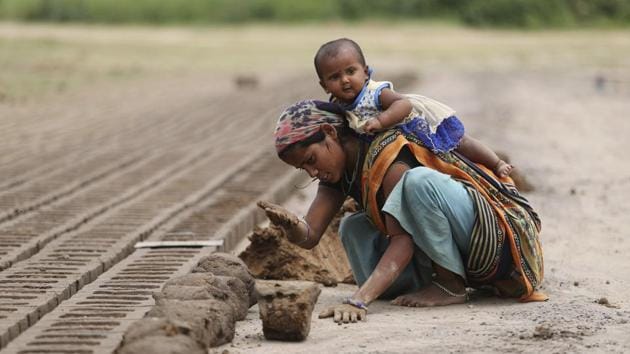India losing almost a million under-5 children annually: Study
Of these, half a million children die within 28 days of being born (neonatal mortality) primarily due to lower respiratory tract infection, pre-term birth and diarrhoeal diseases, show recent papers published in The Lancet.
Even as the under 5 mortality rate (U5MR) in India has reduced by almost 50% in the past two decades, the country is still losing at least a million children annually before they reach their fifth birthday.

Of these, half a million children die within 28 days of being born (neonatal mortality) primarily due to lower respiratory tract infection, pre-term birth and diarrhoeal diseases, show recent papers published in The Lancet.
“U5MR in India reduced by 49% from 83 in 2000 to 42 per 1000 live births in 2017, and neonatal mortality rate (NMR) reduced by 38% from 38 to 23 per 1000 live births during this period. There were 1.04 million under-5 deaths in India in 2017, of which 0.57 million were neonatal deaths, down from 2.24 million under-5 deaths including 1.02 million neonatal deaths in 2000,” says the study published on Tuesday.
Air pollution is also found to have killed about 9% of the under-5 children in 2017 when data for the papers was collated.
The two papers on child survival are published under the India State-Level Disease Burden Initiative, and have the first comprehensive estimates of district-level trends of child mortality in India from 2000.
“It is not like we have not made any gains in the past 20 years. We have. In fact, neonatal mortality rate has reduced by 38% during these years and same goes for under-5 mortality rate that has seen nearly 50% reduction. The government has been focusing a lot on maternal and child care, and we are seeing results,” said Dr Rakhi Dandona, Public Health Foundation of India, one of the lead authors of the study.
“However, what this study also shows is that India now needs to have an area-specific plan in place to reduce child deaths as no two states have the same problem and that is why the solution that worked in one state may not work in another. The study has in detail mentioned the risks and other issues that individual states face, and solutions will have to be created accordingly,” she added.
Although the child mortality and child growth failure indicators have improved substantially across India from 2000 to 2017, the inequality between districts has increased within many states, and there are wide variations between the districts of India.
“There is a silver lining to finding variations within states as it assures that the government is willing to work and has found appropriate solutions to problems they face at the local level, and one district improving exceedingly well means there are workable solutions that can be implemented in other districts, and because it’s the same state, could show similar results,” she said.
Uttar Pradesh and Bihar continue to lag behind. The highest number of under-5 deaths in 2017 was in Uttar Pradesh (312,800 which included 165,800 neonatal deaths) followed by Bihar (141,500 which included 75,300 neonatal deaths).
The NMR is a bigger concern for India as almost 60% districts need higher NMR reduction to individually meet the global Sustainable Development Goals (SDGs) targets. The SDGs are a collection of 17 global goals designed to be a blueprint to achieve a better and more sustainable future for all. The SDGs were set in 2015 by the United Nations General Assembly, and intended to be achieved by 2030.
As per the global SDG target, NMR has to be brought down to 12 per 1000 live births universally by 2030. India’s current NMR remains around 23 per 1000 live births.
“Given the inequalities in the burden and reductions in neonatal mortality across Indian districts, a more granular approach at the district level to determine the strategies for improving newborn survival is needed. Without doubt, continuum of care has to be the pivot around which newborn and child survival strategies must revolve but to homogenize all continuum of care strategies and move them all in tandem is a challenge given the varied implementation capacities of states and districts. We must continue to strive to saturate the continuum of care strategies not only in quantity but also in quality. But in regions with high mortality burden, prioritised interventions should be the focus in the short term along with the holistic continuum of care interventions,” said Dr Siddartha Ramji, professor of pediatrics and neonatology, Maulana Azad Medical College, New Delhi.
The top three causes of neonatal mortality continue to remain preterm birth, birth asphyxia (suffocation) and trauma, and lower respiratory infections, followed by congenital birth defects.
The top three causes of under-5 mortality have been lower respiratory infections, preterm birth, and diarrhoeal diseases, followed by birth asphyxia and trauma.
Experts said nutrition for prospective mothers is crucial. “The nutritional status of young girls is very important as they are going to be future mothers and they need adequate nourishment to avoid complications later on during pregnancy. If not during adolescence, they should at least start taking balanced meals once they get married. It helps to have a well-nourished body before one conceives. As we have seen, by the time women know they are pregnant, and access medical care, it is already about 10 weeks, and by then the cells of the baby have formed. Chances of complications are high in malnourished pregnant woman and the newborn is likely to be malnourished too,” said Dr Hemalatha R, director, National Institute of Nutrition.
Get Current Updates on India News, Lok Sabha election 2024 live, Election 2024 along with Latest News and Top Headlines from India and around the world.




